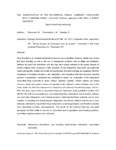Use este identificador para citar ou linkar para este item:
http://www.alice.cnptia.embrapa.br/alice/handle/doc/1036666Registro completo de metadados
| Campo DC | Valor | Idioma |
|---|---|---|
| dc.contributor.author | ROSSMANN, M. | pt_BR |
| dc.contributor.author | CHIARAMONTE, J. B. | pt_BR |
| dc.contributor.author | MENDES, R. | pt_BR |
| dc.date.accessioned | 2016-02-11T11:11:11Z | pt_BR |
| dc.date.available | 2016-02-11T11:11:11Z | pt_BR |
| dc.date.created | 2016-02-11 | pt_BR |
| dc.date.issued | 2015 | pt_BR |
| dc.identifier.citation | In: CONGRESSO BRASILEIRO DE MICROBIOLOGIA, 28., Florianópolis. Anais... Florianópolis: Sociedade Brasileira de Microbiologia, 2015. Ref. 1865-1. | pt_BR |
| dc.identifier.uri | http://www.alice.cnptia.embrapa.br/alice/handle/doc/1036666 | pt_BR |
| dc.description | Abstract: Plant breeding is an important instrument to improve crop productivity. However, studies have shown that plant breeding, as well as the use of management practices such as tillage and fertilization, influence the plant root microbiome and also may have caused reduction in the genetic diversity of modern cultivars when compared to their ancestors. As the rhizosphere microbiome can profoundly impact plant growth, nutrition and health, we hypothesized that plant breeding can negatively affect the recruitment of beneficial microbes in the rhizosphere and interactions with their favorable microbial partners. A greenhouse experiment was conducted to assess the composition of the rhizosphere mycorrhizal fungi community in wheat (Triticum aestivum) varieties, modern cultivars and wheat ancestors. Plants were grown in forest and agricultural soils, collected in wheat cultivation area in São Paulo, Brazil. The DNA was extracted from rhizospheric soil collected in the flowering stage, and the r RNA 18S gene copy number of mycorrhizal fungi was determined using quantitative real-time PCR (qPCR). The bulk soil presented less mycorrhizal fungi than rhizospheric soil of modern cultivars and more than rhizospheric soil of wheat ancestors indicating that these materials can be more selective in recruiting and structuring the rhizosphere microbiome. Modern cultivars were more intensely colonized by mycorrhizal fungi compared to ancestral genotypes and therefore possibly more dependent on these microorganisms. The results do not evidence that new crop plant genotypes lost their ability to respond to mycorrhizal due to agricultural and breeding practices, and further analyses needs to be performed. | pt_BR |
| dc.language.iso | eng | eng |
| dc.rights | openAccess | eng |
| dc.subject | Crop breeding | pt_BR |
| dc.subject | Rhizosphere microbiome | pt_BR |
| dc.subject | Plant-microbe interactions | pt_BR |
| dc.subject | Mycorrhizal community | pt_BR |
| dc.title | Quantification of the mycorrhizal fungal community associated with a modern wheat cultivar (Triticum aestivum) and with a wheat ancestor. | pt_BR |
| dc.type | Resumo em anais e proceedings | pt_BR |
| dc.date.updated | 2016-02-12T11:11:11Z | pt_BR |
| dc.subject.thesagro | Trigo | pt_BR |
| dc.subject.thesagro | Triticum Aestivum | pt_BR |
| riaa.ainfo.id | 1036666 | pt_BR |
| riaa.ainfo.lastupdate | 2016-02-12 | pt_BR |
| dc.contributor.institution | M. ROSSMANN; J. B. CHIARAMONTE, ESALQ/USP; RODRIGO MENDES, CNPMA. | pt_BR |
| Aparece nas coleções: | Resumo em anais de congresso (CNPMA)  | |
Arquivos associados a este item:
| Arquivo | Descrição | Tamanho | Formato | |
|---|---|---|---|---|
| 2015RA074.pdf | 71,93 kB | Adobe PDF |  Visualizar/Abrir |









